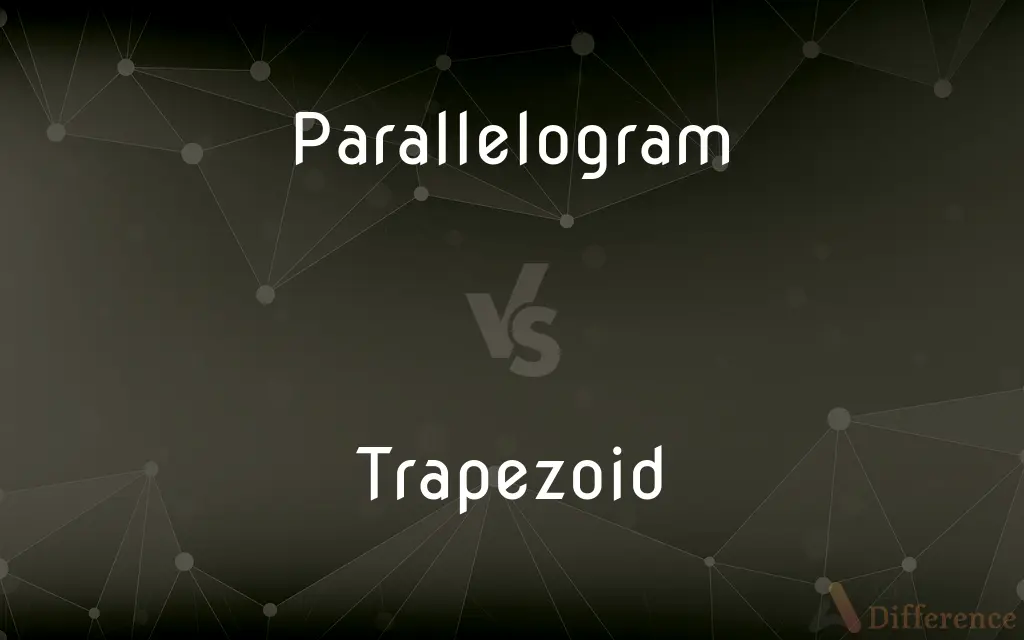Parallelogram vs. Trapezoid — What's the Difference?
By Fiza Rafique & Maham Liaqat — Updated on March 15, 2024
A parallelogram is four-sided figure with opposite sides parallel & equal in length, and opposite angles equal, while trapezoid (or trapezium in British English) is defined by having at least one pair of parallel sides, differing in shape and properties.

Difference Between Parallelogram and Trapezoid
Table of Contents
ADVERTISEMENT
Key Differences
A parallelogram is characterized by both pairs of opposite sides being parallel and equal in length, which ensures that opposite angles are also equal. This geometric property gives parallelograms a unique set of attributes, such as the fact that the diagonals bisect each other. On the other hand, a trapezoid is recognized by having only one pair of parallel sides, referred to as the bases, with the non-parallel sides being the legs, leading to a more varied set of shapes and properties.
The area calculation for a parallelogram is straightforward, requiring the base length and the height perpendicular to the base. This simplicity is due to its symmetrical properties. In contrast, the area of a trapezoid is calculated by averaging the lengths of the parallel sides (the bases) and multiplying by the height, reflecting its asymmetrical nature.
In terms of symmetry, parallelograms often exhibit line symmetry through their diagonals, depending on the specific type (e.g., rectangles and rhombi). Trapezoids, however, may or may not have line symmetry, largely dependent on whether they are isosceles trapezoids (with equal-length non-parallel sides) or not.
Another distinctive feature of parallelograms is that they always have two pairs of equal angles, which is a direct result of having two pairs of parallel sides. Trapezoids do not share this characteristic universally; equal angles in trapezoids occur only under specific conditions, such as in isosceles trapezoids, where the base angles are equal.
While both parallelograms and trapezoids play significant roles in geometry, offering a wealth of practical and theoretical applications, their distinct properties and definitions make them suitable for different kinds of problems and explorations within the field of mathematics.
ADVERTISEMENT
Comparison Chart
Parallel Sides
Two pairs
One pair
Area Formula
Base × Height
(Sum of parallel sides)/2 × Height
Symmetry
Often has line symmetry
May have line symmetry if isosceles
Angles
Opposite angles are equal
Base angles are equal only in isosceles trapezoids
Diagonals
Bisect each other
May or may not bisect each other evenly
Shape Variability
Less variable, always a parallelogram
More variable, ranging from regular to irregular forms
Height
Perpendicular distance between parallel sides
Perpendicular distance between bases
Special Cases
Includes rectangles, rhombi, and squares
Includes isosceles trapezoids
Compare with Definitions
Parallelogram
A parallelogram has opposite sides parallel and equal in length.
A rectangle is a parallelogram with four right angles.
Trapezoid
A trapezoid has only one pair of parallel sides.
In an isosceles trapezoid, the non-parallel sides are also equal in length.
Parallelogram
Its diagonals bisect each other.
In a rhombus, diagonals bisect at right angles and are perpendicular.
Trapezoid
It may or may not have line symmetry, depending on the leg lengths.
An isosceles trapezoid has line symmetry across the perpendicular bisector of its bases.
Parallelogram
All angles add up to 360 degrees, with opposite angles equal.
In any parallelogram, if one angle is 90 degrees, all angles are 90 degrees.
Trapezoid
Trapezoids can be classified as isosceles if the legs are equal.
Isosceles trapezoids have equal base angles and leg lengths.
Parallelogram
Parallelograms include squares, rectangles, and rhombi.
Squares are parallelograms with all sides equal and all angles right.
Trapezoid
The area is calculated by averaging the lengths of the bases times the height.
The area of a trapezoid is found by adding the lengths of the bases, dividing by 2, and then multiplying by the height.
Parallelogram
The area is calculated as the base times the height.
The area of a parallelogram can be found by multiplying its base by its perpendicular height.
Trapezoid
Non-parallel sides are called legs.
The legs of a trapezoid can vary in length, unlike the sides of a parallelogram.
Parallelogram
In Euclidean geometry, a parallelogram is a simple (non-self-intersecting) quadrilateral with two pairs of parallel sides. The opposite or facing sides of a parallelogram are of equal length and the opposite angles of a parallelogram are of equal measure.
Trapezoid
In Euclidean geometry, a convex quadrilateral with at least one pair of parallel sides is referred to as a trapezium () in English outside North America, but as a trapezoid () in American and Canadian English. The parallel sides are called the bases of the trapezoid and the other two sides are called the legs or the lateral sides (if they are not parallel; otherwise there are two pairs of bases).
Parallelogram
A four-sided plane figure with opposite sides parallel.
Trapezoid
A quadrilateral having two parallel sides.
Parallelogram
(geometry) A convex quadrilateral in which each pair of opposite edges are parallel and of equal length.
Trapezoid
Chiefly British A trapezium.
Parallelogram
Either of two rectangular areas (respectively the large parallelogram and the small parallelogram) abutting the goal line in front of the goal. (Since 1986 officially named the large rectangle and small rectangle, though the older names are still occasionally used.)
Trapezoid
(Anatomy) A small bone in the wrist, situated near the base of the index finger.
Parallelogram
A right-lined quadrilateral figure, whose opposite sides are parallel, and consequently equal; - sometimes restricted in popular usage to a rectangle, or quadrilateral figure which is longer than it is broad, and with right angles.
Trapezoid
(Sports) An area in the shape of a trapezoid marked behind the goal line and the goal in ice hockey, where the goalie is allowed to play the puck.
Parallelogram
A quadrilateral whose opposite sides are both parallel and equal in length
Trapezoid
A (convex) quadrilateral with two (non-adjacent) parallel sides.
Trapezoid
A convex quadrilateral with no sides parallel.
Trapezoid
(anatomy) The trapezoid bone of the wrist.
Trapezoid
A plane four-sided figure, having two sides parallel to each other.
Trapezoid
A bone of the carpus at the base of the second metacarpal, or index finger.
Trapezoid
Having the form of a trapezoid; trapezoidal; as, the trapezoid ligament which connects the coracoid process and the clavicle.
Trapezoid
Of or pertaining to the trapezoid ligament; as, the trapezoid line.
Trapezoid
A quadrilateral with two parallel sides
Trapezoid
The wrist bone between the trapezium and the capitate bones
Common Curiosities
Can a trapezoid have all sides of equal length?
No, that would make it a parallelogram (specifically, a square or rhombus) rather than a trapezoid.
How do you calculate the area of a parallelogram and a trapezoid?
For a parallelogram, multiply the base by the height. For a trapezoid, average the lengths of the bases and multiply by the height.
Is it possible for a trapezoid to have more than one pair of parallel sides?
If it has more than one pair of parallel sides, it is not a trapezoid but a parallelogram.
Are the diagonals of a trapezoid always equal in length?
No, trapezoid diagonals are not necessarily equal in length; this depends on the specific shape and type of trapezoid.
What is an isosceles trapezoid?
It's a trapezoid with equal-length non-parallel sides and equal base angles.
Do all parallelograms have right angles?
Not all; only rectangles and squares (which are types of parallelograms) have right angles.
Why do the diagonals of a parallelogram bisect each other?
This property is due to the parallelogram's parallel sides creating congruent triangles when the diagonals intersect.
Can a parallelogram have rounded corners?
No, by definition, a parallelogram is a straight-sided figure.
What makes a parallelogram different from a trapezoid?
A parallelogram has two pairs of parallel sides, while a trapezoid has only one pair.
Do all trapezoids have one right angle?
No, trapezoids do not necessarily have any right angles unless specifically designed as a right trapezoid.
Can a parallelogram be considered a trapezoid?
In some mathematical contexts, parallelograms can be considered special types of trapezoids (with two pairs of parallel sides), but traditionally, they are treated as distinct due to their unique properties.
What determines the height of a trapezoid?
The height is the perpendicular distance between the two parallel sides (bases).
Share Your Discovery

Previous Comparison
Manufacturing vs. Service
Next Comparison
Distinction vs. SkillAuthor Spotlight
Written by
Fiza RafiqueFiza Rafique is a skilled content writer at AskDifference.com, where she meticulously refines and enhances written pieces. Drawing from her vast editorial expertise, Fiza ensures clarity, accuracy, and precision in every article. Passionate about language, she continually seeks to elevate the quality of content for readers worldwide.
Co-written by
Maham Liaqat













































